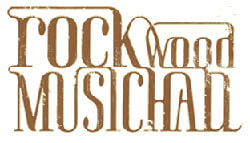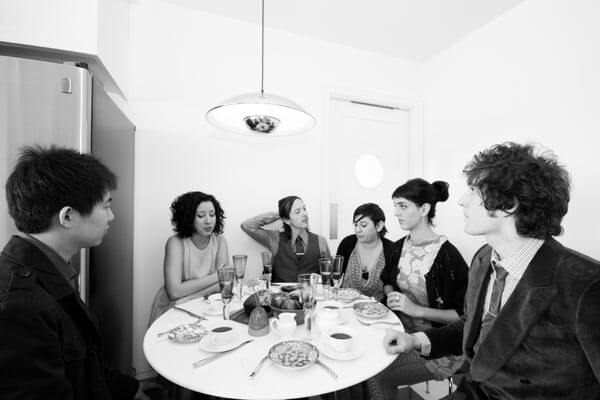 yMusic and New Amsterdam Records put on a release party earlier this month for their debut album, Beautiful Mechanical, at Rockwood Music Hall on the Lower East Side. The hip and charming-but-smallish venue was packed to the gills with twenty- and thirty-somethings and quite a few recognizable new music composers and performers.
yMusic and New Amsterdam Records put on a release party earlier this month for their debut album, Beautiful Mechanical, at Rockwood Music Hall on the Lower East Side. The hip and charming-but-smallish venue was packed to the gills with twenty- and thirty-somethings and quite a few recognizable new music composers and performers.
Every once in a while an album is assembled, or a live concert is programmed, in such a graceful way that one’s jaw drops. The different musics are sufficiently different to keep the listening experience fresh and forward-moving, while having enough in common to not end up the aural equivalent of a buffet. The release party for yMusic’s Beautiful+Mechanical at Rockwood Music Hall on the Lower East Side was both that rare album and that rare concert, and as I left I found myself marveling at how well it all worked. The music, and the performances, were full of the energy, fun, and vibrancy that has become New Amsterdam Records’ trademark. Even violist (and Q2 radio host) Nadia Sirota’s casually graceful and funny emceeing was impressive.

yMusic is a chamber sextet (flute, clarinet, trumpet, violin, viola, and cello) of genre-versatile musicians who list their conservatory training credentials and orchestra appearances alongside lists of bands and pop/rock acts with whom they’ve collaborated. It’s the sort of thing that might scream “look at me! I’m cool!” in less capable hands, but these six players are so virtuosic individually and as a group, and so obviously sincere in their love of what they’re doing, that no alarm bells went off. The composers, too, wear their non-classical alter-egos and their classical bona fides (Son Lux/Ryan Lott, My Brightest Diamond/Shara Worden, St. Vincent/Annie Clark, plus Gabriel Kahane and New Amsterdam co-founders Judd Greenstein and Sarah Kirkland Snider) with the “so what?” carefree attitude that has become almost de rigueur for young composers active below 59th Street. For those of us writing about events within this post-Bang on a Can subculture, it has become practically mandatory to write paragraphs like these, which I think says everything that needs to be said about the strength and sustainability of what this subculture is doing. “New Amsterdam” is as much an identifiable sound as “Bang on a Can” is, and that’s pretty remarkable after only a few years on the scene and the charts.

I’m not going to provide a blow-by-blow description of each track (piece?) on the album, only because you can find plenty of that elsewhere and I think you’d be better served by just going here, where you can (and should!) stream the entire record in its entirety. And then buy it. What I do think is important to talk about, though, is how shockingly well the whole album hangs together. Musically, the pieces and composers have personality to spare, but they also all fit into a remarkably cohesive self-contained aesthetic: rhythmically pulse-based (though not necessarily ostinato-based), largely modal harmonically, often drawing upon (if not making explicit reference to) vernacular traditions, and staying for the most part within the world of standard instrumental techniques. Shara Worden’s two contributions––”A Whistle, a Tune, a Macaroon” and “A Paper, a Pen, a Note to a Friend”––lived in a more extended-technique territory, but the sounds served largely to color and spice musical material that fit very well within and alongside the album’s overall language, more fun surprise and ad-hoc percussion than proclamation of high seriousness. Sarah Kirkland Snider’s “Daughter of the Waves”, which takes its title from the translation of the name of Kirkland Snider’s newborn daughter, also ventured briefly into that territory with an episode of crunches and groans in the strings, but was overall gorgeously lyrical, and for me formed a pair with Annie Clark’s “Proven Badlands,” another folk-inflected and land/seascape-evocative piece, but one that grew to a striking rhythmic climax. Greenstein’s “Clearing, Dawn, Dance” reminded me (positively) of his Change, written for NOW Ensemble, in its rhythmic playfulness and relentlessly positive emotional trajectory, and seemed to call back to the opening (and title) track, Ryan Lott’s “Beautiful Mechanical”, which employed similar rhythmic tools to very different, but every bit as successful, effect––forceful where the Greenstein was relaxed, intense and dark-hued where the Greenstein was upbeat and exuberant. Following these three pairs, Gabriel Kahane’s “Song” is the middle movement of a trumpet pocket-concerto (as opposed to a pocket-trumpet concerto––I know, I was confused too), and trumpeter CJ Camerieri made the high and perilously quiet solo part sound easy. And since it’s Gabriel Kahane, the woozy electric guitar and off-kilter pop ballad-ness of it make a kind of coda: a summing-up, a tying-together.
The performance was, again, stunning, but two things deserve special mention: CJ Camerieri’s heroic work on trumpet, playing seven taxing, high parts back-to-back without the breaks afforded by the recording studio; and just the fact that nearly everyone doubled: flutist Alex Sopp on piccolo, clarinetist Hideaki Aomori on bass clarinet, violinist Rob Moose on electric guitar, and Camerieri on horn. Several times throughout the evening I found myself glancing around the room, or just lost in the music, when my attention would be pulled (yanked) back to the stage by some strange burst of color, and I’d briefly wonder where the ____ player came from. It was a magical show, and not just because of the instrumental rabbits coming out of hats.
—
Jeremy Howard Beck is a New York-based composer, as well as an active trombonist. Follow him on Twitter: @jeremyhowardboo
























